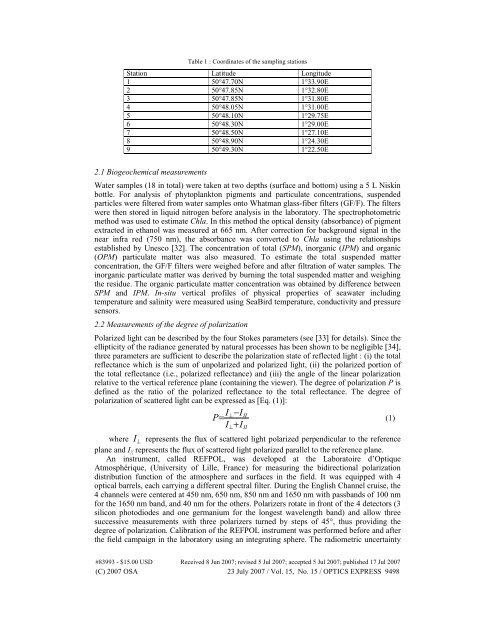Determination of biogeochemical properties of marine particles ...
Determination of biogeochemical properties of marine particles ...
Determination of biogeochemical properties of marine particles ...
You also want an ePaper? Increase the reach of your titles
YUMPU automatically turns print PDFs into web optimized ePapers that Google loves.
Table 1 : Coordinates <strong>of</strong> the sampling stations<br />
Station Latitude Longitude<br />
1 50°47.70N 1°33.90E<br />
2 50°47.85N 1°32.80E<br />
3 50°47.85N 1°31.80E<br />
4 50°48.05N 1°31.00E<br />
5 50°48.10N 1°29.75E<br />
6 50°48.30N 1°29.00E<br />
7 50°48.50N 1°27.10E<br />
8 50°48.90N 1°24.30E<br />
9 50°49.30N 1°22.50E<br />
2.1 Biogeochemical measurements<br />
Water samples (18 in total) were taken at two depths (surface and bottom) using a 5 L Niskin<br />
bottle. For analysis <strong>of</strong> phytoplankton pigments and particulate concentrations, suspended<br />
<strong>particles</strong> were filtered from water samples onto Whatman glass-fiber filters (GF/F). The filters<br />
were then stored in liquid nitrogen before analysis in the laboratory. The spectrophotometric<br />
method was used to estimate Chla. In this method the optical density (absorbance) <strong>of</strong> pigment<br />
extracted in ethanol was measured at 665 nm. After correction for background signal in the<br />
near infra red (750 nm), the absorbance was converted to Chla using the relationships<br />
established by Unesco [32]. The concentration <strong>of</strong> total (SPM), inorganic (IPM) and organic<br />
(OPM) particulate matter was also measured. To estimate the total suspended matter<br />
concentration, the GF/F filters were weighed before and after filtration <strong>of</strong> water samples. The<br />
inorganic particulate matter was derived by burning the total suspended matter and weighing<br />
the residue. The organic particulate matter concentration was obtained by difference between<br />
SPM and IPM. In-situ vertical pr<strong>of</strong>iles <strong>of</strong> physical <strong>properties</strong> <strong>of</strong> seawater including<br />
temperature and salinity were measured using SeaBird temperature, conductivity and pressure<br />
sensors.<br />
2.2 Measurements <strong>of</strong> the degree <strong>of</strong> polarization<br />
Polarized light can be described by the four Stokes parameters (see [33] for details). Since the<br />
ellipticity <strong>of</strong> the radiance generated by natural processes has been shown to be negligible [34],<br />
three parameters are sufficient to describe the polarization state <strong>of</strong> reflected light : (i) the total<br />
reflectance which is the sum <strong>of</strong> unpolarized and polarized light, (ii) the polarized portion <strong>of</strong><br />
the total reflectance (i.e., polarized reflectance) and (iii) the angle <strong>of</strong> the linear polarization<br />
relative to the vertical reference plane (containing the viewer). The degree <strong>of</strong> polarization P is<br />
defined as the ratio <strong>of</strong> the polarized reflectance to the total reflectance. The degree <strong>of</strong><br />
polarization <strong>of</strong> scattered light can be expressed as [Eq. (1)]:<br />
I⊥−III<br />
P=<br />
(1)<br />
I⊥+<br />
III<br />
where I ⊥ represents the flux <strong>of</strong> scattered light polarized perpendicular to the reference<br />
plane and I || represents the flux <strong>of</strong> scattered light polarized parallel to the reference plane.<br />
An instrument, called REFPOL, was developed at the Laboratoire d’Optique<br />
Atmosphérique, (University <strong>of</strong> Lille, France) for measuring the bidirectional polarization<br />
distribution function <strong>of</strong> the atmosphere and surfaces in the field. It was equipped with 4<br />
optical barrels, each carrying a different spectral filter. During the English Channel cruise, the<br />
4 channels were centered at 450 nm, 650 nm, 850 nm and 1650 nm with passbands <strong>of</strong> 100 nm<br />
for the 1650 nm band, and 40 nm for the others. Polarizers rotate in front <strong>of</strong> the 4 detectors (3<br />
silicon photodiodes and one germanium for the longest wavelength band) and allow three<br />
successive measurements with three polarizers turned by steps <strong>of</strong> 45°, thus providing the<br />
degree <strong>of</strong> polarization. Calibration <strong>of</strong> the REFPOL instrument was performed before and after<br />
the field campaign in the laboratory using an integrating sphere. The radiometric uncertainty<br />
#83993 - $15.00 USD Received 8 Jun 2007; revised 5 Jul 2007; accepted 5 Jul 2007; published 17 Jul 2007<br />
(C) 2007 OSA 23 July 2007 / Vol. 15, No. 15 / OPTICS EXPRESS 9498
















